SCMs should drive a “just the customer” approach, not “just in time.”
Customer needs are rapidly evolving with many consumers expecting more ethically- and sustainably-built products, even if they cost more. To meet these changes, businesses need to shift from strategies that prioritize cost reduction and efficiency to those that center around the customer. This will involve elevating the role of supply chain management from a “back of the house” execution-only focused department to a strategic partner with a seat at the senior leadership table.
In this report, we’ll share insights from our 2022 Supply Chain Management Trends survey* of 300 SCM professionals at small and midsize businesses, as well as guidance on how to create a customer-centric supply chain along with some tips to get you started.
/ Key survey highlights
Committing to meet consumer sustainability demands: 80% of SMB supply chains plan to increase or continue to invest in sustainability efforts.
Investing in talent accelerates: 65% of SMB supply chains plan to hire more supply chain talent in 2023. And 43% plan to promote and/or hire one or more supply chain specialist to a senior leadership position.
Incorporating SCM into the business strategy: Only 31% of SCM leaders regularly meet with IT and operations for planning and strategy meetings. Another 55% do so sometimes or as needed.
In this article, we’re taking a “sense, shift, steer” approach to discuss how to create a customer-centric supply chain strategy to meet current consumer behavior. You’ll need to sense the changes in customer demands, start to shift your priorities to meet these demands, and begin to steer the business toward the long-term goals of a truly customer-centric supply chain model.
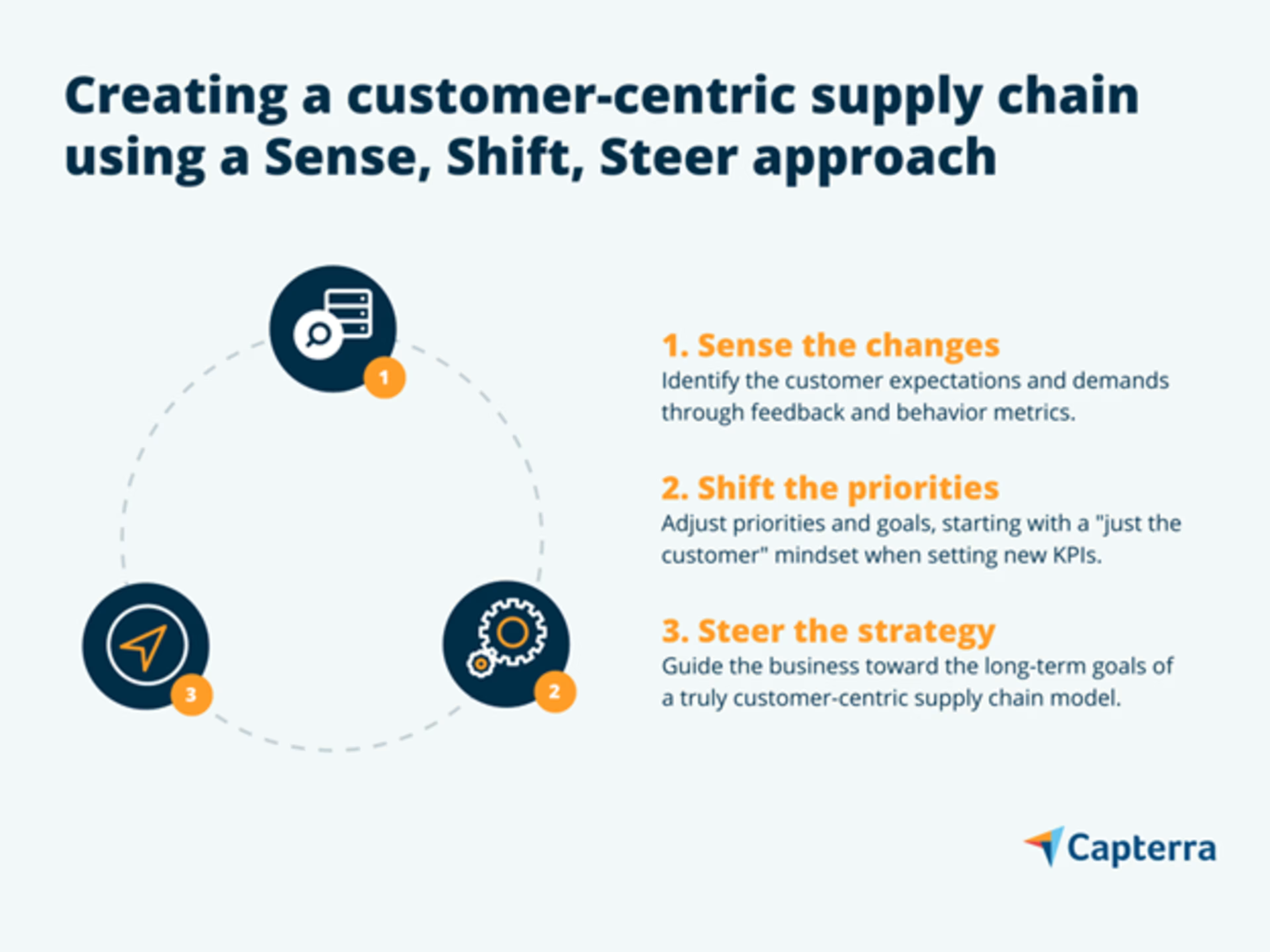
Let’s start with what you can do now to better understand what your customers want.
Sense the change: Understand your consumers’ expectations
The first step in building a customer-centric supply chain is to identify what your customers want. To do this, you’ll need to partner with other departments in your organization to gather customer behavior information. This can be in the form of feedback on the top products sold, what marketing campaigns have been resonating with customers, and reasons for returned items.
Focus your attention on the feedback and behavior specifically related to shipping and delivery, product quality and price, and inventory demands as these are the areas where you can have direct impact on improving the customer experience. Then compare your current suppliers, business processes, and operation goals to what your customers are saying to identify areas of opportunity, both short and long term.
/ Analyst’s tip
While this type of work is atypical for traditional supply chain managers, it’s a role that you can hire for. If you’re included in the 65% of SMBs that are planning to hire more SCM resources in 2023, be sure to include a supply chain strategist among them. This person can perform the work outlined in this section and be the collaborative link needed to maintain the new customer-centric strategy.
To get you started
Let’s go over the top trend across nearly all consumer products: sustainability. Consumers want sustainable and ethically-made products. In fact, 84% of consumers purchased a sustainable product in the second half of 2022, up from 67% in 2021**. And they’re willing to pay a bit more for it—about 8% more on average***.
What you can do:
Prioritize product value over cost cutting: Price was king for consumers for decades, so it can be tough to shift away from that thinking—but it’s important to update your business strategy to keep up with changes.
Identify current sustainability wins: Review your existing suppliers, product design, and logistics methods to see where you’re already acting sustainably and share this info with your sales and marketing teams. Your customers want to know what sustainability efforts you’re making now.
Confirm this expectation with your current customers: If you’re unsure if this new consumer demand impacts your business, discuss customer feedback with your sales and marketing teams to confirm.
The demographics of your specific customer base will impact this and other expectations that they have for your product. For example, here’s consumer behavior for sustainable products purchased by generation:
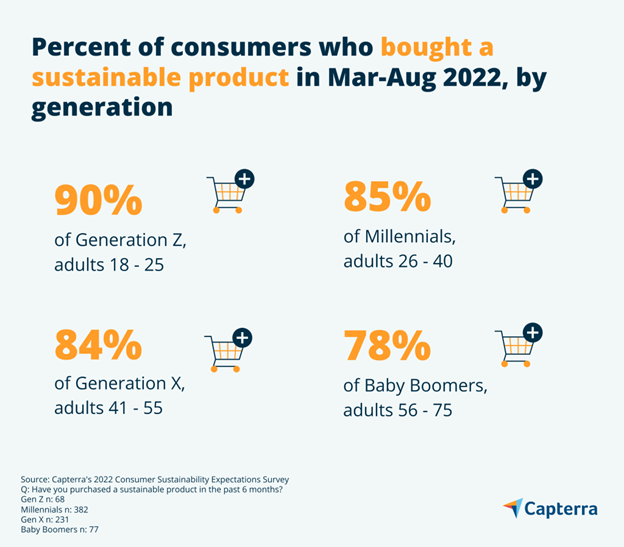
Check out the full report on consumer expectations for sustainability here.
Next we’ll discuss what shifting your supply chain strategy to be customer-centric looks like.
Shift the priorities: Update products and/or logistics to meet consumer expectations
After getting a sense of the expectations your customers have, you can begin to make shifts in your processes and goals to meet them. Instead of having priorities set by senior management or traditional supply chain management best practices, align your top KPIs and business processes with what your customers value most.
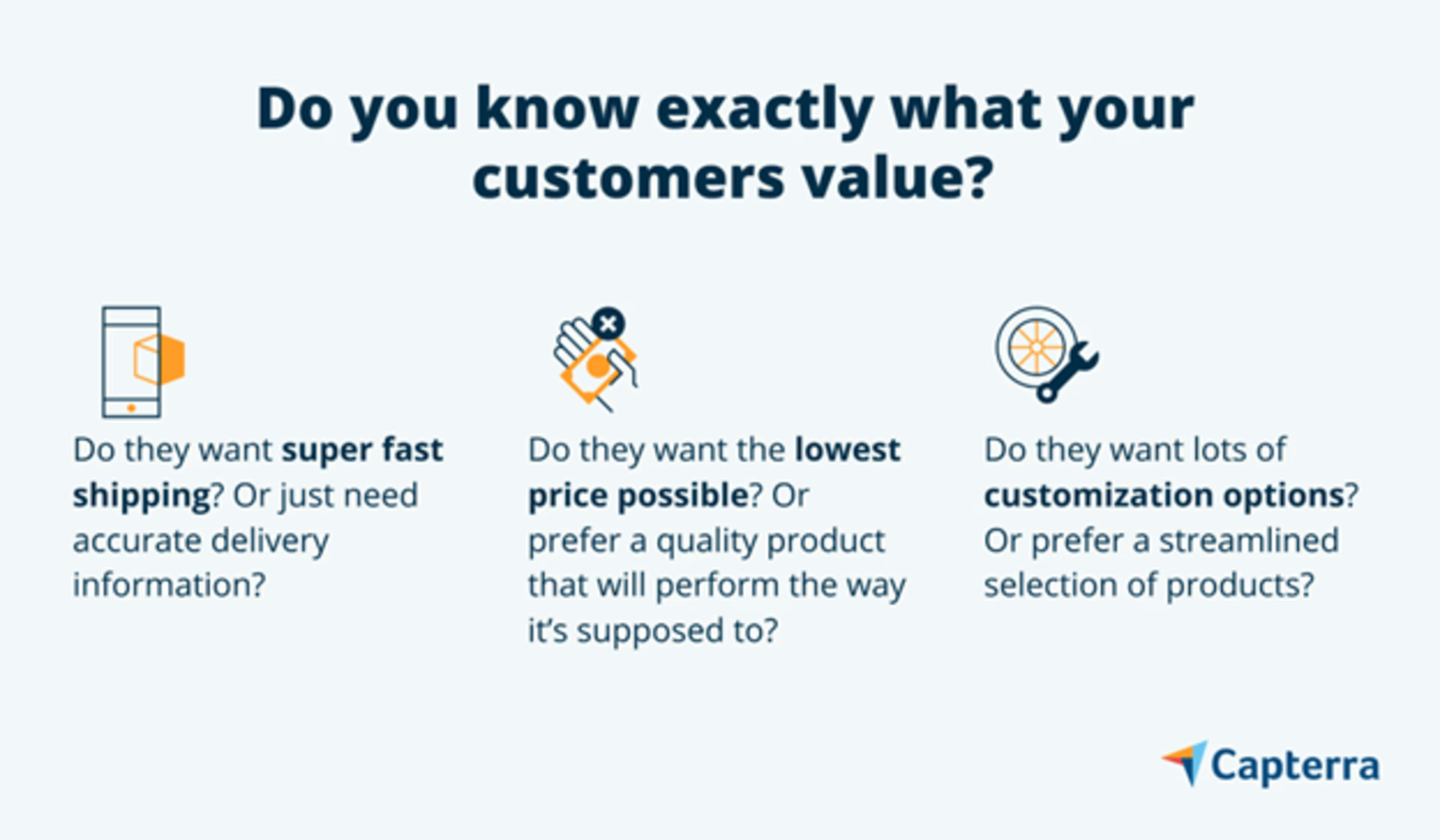
From there you can shift your priorities accordingly, making changes to both product design and logistics processes.
Tips for shifting priorities:
Review your supplier network: If you’re shifting toward higher-quality and/or sustainably-made products, you’ll need suppliers that meet these needs. Talk with your current suppliers about ways to improve the product, but don’t be afraid to find new suppliers if needed.
Assess shipping partners: Similar to your product suppliers, you need logistics partners that can operate in ways that meet your customers’ expectations.
Collaborate on product design: From packaging to the product itself, the product design should be a collaborative effort involving the product engineers, sales/marketing, and SCM to have the strongest outcome. Your insight on the capabilities of suppliers and partners can guide product changes in a realistic and effective direction.
Now let’s get into steering the strategy in the long term so your supply chain can be successfully customer-centric.
Steer the strategy: Establish a collaborative committee
In 2023, 43% of SMBs with supply chains plan to promote and/or hire one or more supply chain specialists to a senior leadership position. We see this trend because supply chain leaders are thinking more strategically than ever, as opposed to the strictly execution-only role they’ve held in the past.
As the business develops long-term, customer-centric goals and strategies, SCM leaders offer insight on ways to meet these goals. Especially with priorities such as meeting consumer demand for sustainability, SCM leaders can help develop realistic and innovative ways to better leverage supplier and logistics relationships and capabilities to meet these expectations.
Less than one-third (31%) of SCM leaders regularly meet with IT and operations leaders for planning and strategy meetings. Another 55% do so only sometimes or as needed.
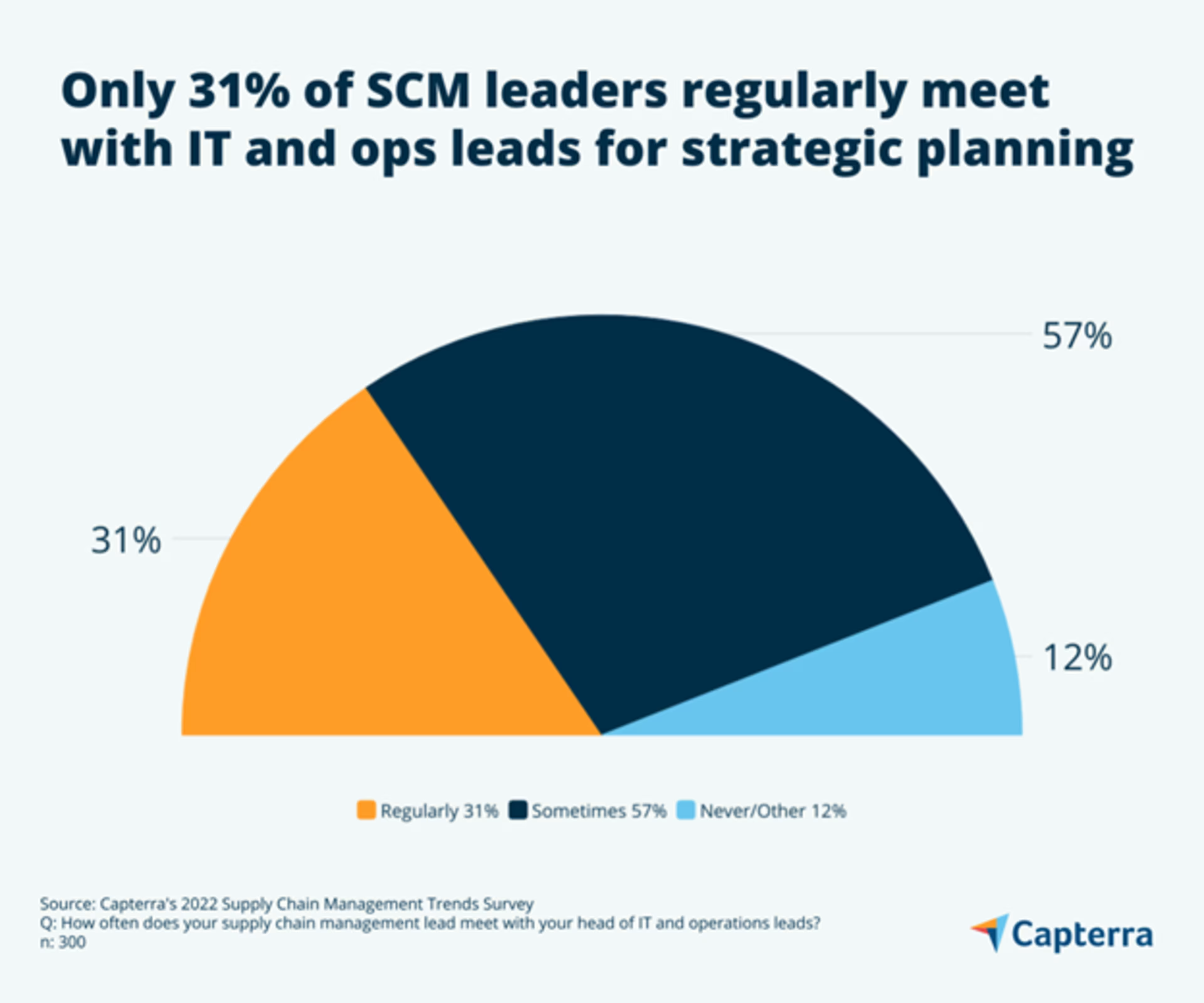
Not only should these numbers be much higher, but this approach also doesn’t go far enough. Instead, here’s what to do:
Include the SCM leader in business strategy meetings: Ideally, you’ll create or already have a C-suite strategy steering committee that includes the SCM leader. This committee should keep customers’ behavior and expectations front and center with a focus on delivering on those wants. If you’re planning to hire or already have a senior SCM leader, this person needs to have a seat on this committee.
Partner with IT, HR, sales/marketing, and others regularly: Along with working on the long-term business strategy in the committee, the SCM leader should collaborate with heads of other key departments often to identify areas of improvement and make course corrections together as needed.
A new path forward: the customer-centric supply chain strategy
Throughout this report, we shared insights and recommendations for creating a small business supply chain strategy that keeps the customers’ expectations front and center. This is a shift from a traditional mindset of continuously driving down prices and delivering “just in time” to a collaborative “just the customer” approach where SCM leaders help guide the overall business strategy.
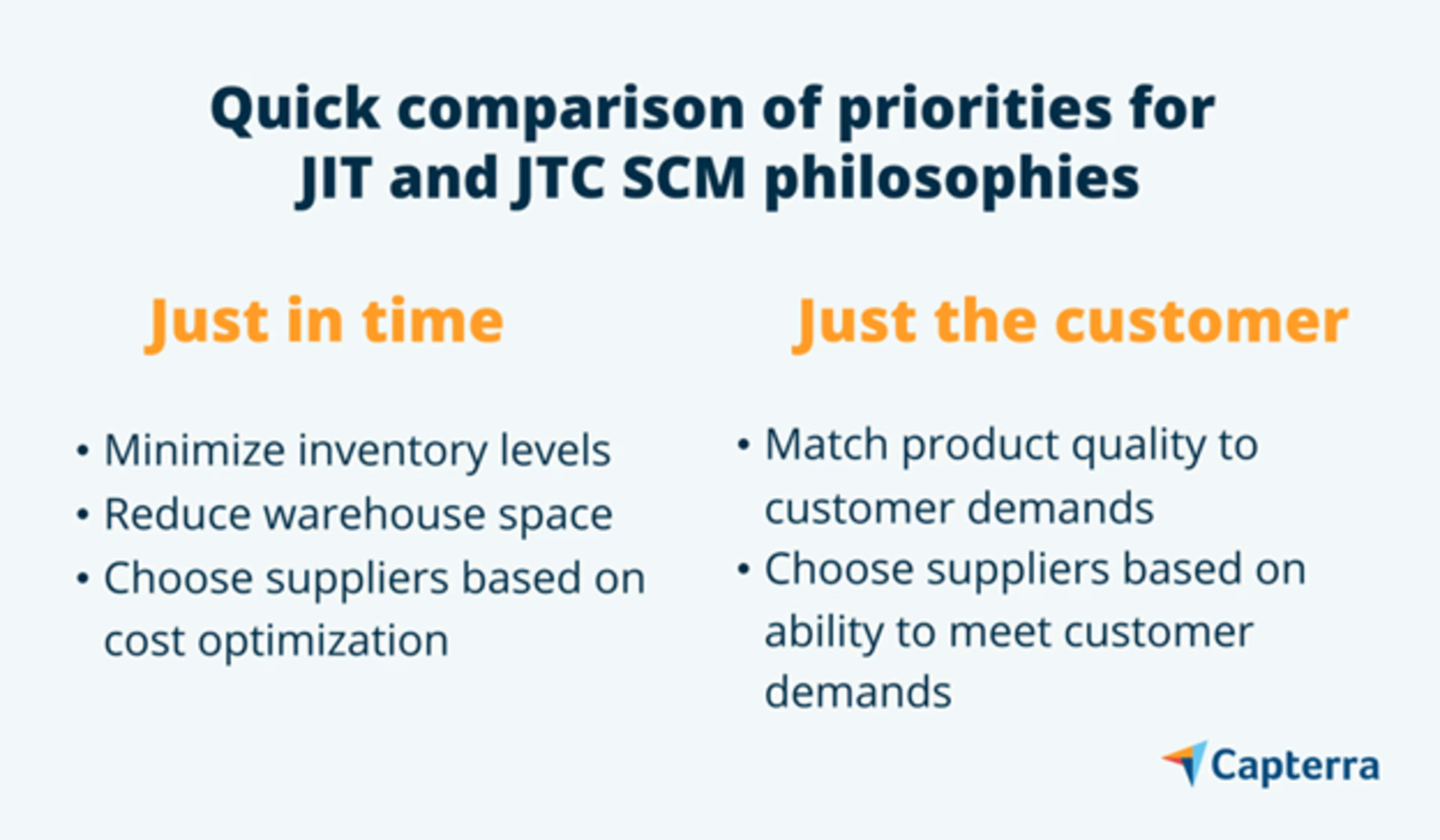
The specifics of how, when, and to what degree you shape your supply chain management strategies away from JIT toward JTC should be determined by your SCM and senior leadership together. From hiring a supply chain strategy specialist to promoting an SCM leader to the executive level, your small business can leverage the insights and innovative thinking of today’s supply chain leaders to create a competitive, customer-centric strategy by incorporating the recommendations and insights shared here.
Looking to learn more?
A deep dive into consumer sustainability demands: Consumer Expectations for Sustainability Are Accelerating Despite Inflation
A quick guide for shifting toward a customer-centric business: 5 Tips for Creating a Powerful Customer-Focused Culture
Capterra’s series on the core pillars of customer experience, starting with how to better understand your customers: 5 Ways to Better Understand Your Customers
